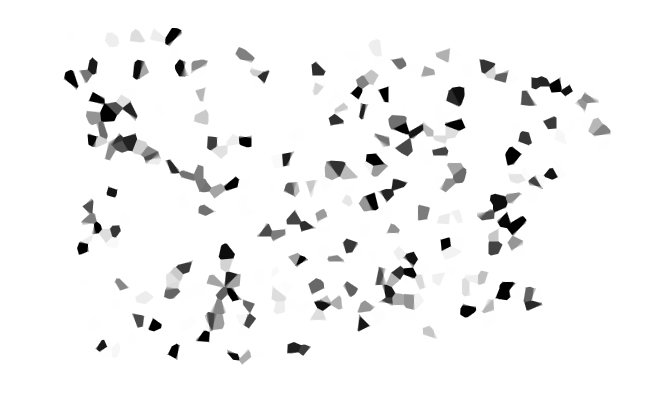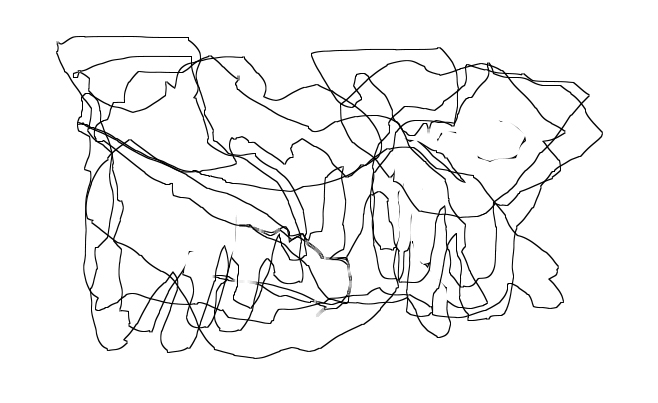Five Crystals

I
A form descends as a pair, stopping at a fixed edge. Each node recedes into a sketchy blade rejoining a body still hidden. The delicacy with which the surface is touched confirms both transference of power and presence in time. Weight, anchored at the rear, presses upward into a belt of shadow before being redistributed to the slopes beyond. Outward projection is near-hidden by a comb of digits, each with its own particular curvature pitted in uncertain relation to its neighbour. Some segments come down full, while others slant, resulting in a precarious, tangential pressures at each tip. The points of contact are viable, indicative co-ordinates that make sense of a difficult, unstable, perhaps even exhausted structure. At the forefront are banks of further shallow lozenges—tabs of resistant polymer—cramped by massive side-drifts, a motive looping outward as if hitched to glacial creep. These are plainly landscape forms or images. Their suggested projections and indents are all forms shaped by needling pressures. Etched rivulets run to meet hard lines, tilts combine to bunch forces up onto a bloated plate. A fold is crystalline. On the underside, a flurry of grains melt into a radial dial of finger lakes. Fissures fill with light. Occupiable space is tentatively visualised.
II
Instead of entire landscapes—island teeth pulled from a gummy ocean, exposed on a dias—the structures constitute curious bubbles of architecture: an intricate cave complex inverted, negative to positive. The swollen terminal building of a burial warren, with entrances and exits pitched against a smooth plane. Each gate is accompanied by its ghost, the one interchanging with the other. Each comes with its set of fronds, irregular fascias that indicate a loss of fluidity, junctions close to fusing. The image is one of density, on the one hand, a view phasing upon rotation. Seen from the side, the phalanx becomes nothing more than a bulb of celeriac, a stringy composition of Arcimboldo.
III
A confusion of expected articulations occurs, as established surface patterns are not continued throughout each form. In fact, they quickly become separated from directional flow, passing into diffuse asymmetry. There are cantilevers, only visible from the front, with thickened shadow glimpsed underneath a main canopy. A corrin ring links indirectly between knuckles. Such forms alter through the years, expand and contract. The external covering loosens from whorled nets, thinning as submerged domes protrude when the temperature drops. All motion is nonetheless sealed inside the carapace. It is possible to imagine procedures by which the main forms have separated out into fronds, dark operations requiring immense forces to break up gathered units. There is much evidence of plastic destruction, as well as sudden betrayals resulting in perverse twistings, atrophied expanse. Why did these parts not detach entirely to become separate entities? The possibility of a further loss of structural integrity is clear, especially considering the ceaseless passage of particles through matter, reflecting against a spatial backing plate. These are joints of basalt, pocked with annular indentations and tasseled with dead flesh.
IV
The image undergoes an inexplicable recovery. Forms are no longer opaque. Raised areas remain hidden, turned over, released over time to allow gravity to hang suspended. The poise of each outline is more definite, with no shading, as if full transparency were sought. Still there are eroded patches, suggestive of errors in the image, blurring, an awareness struck by a beam and scattered. Below an interosseous platform, pulsing branches settle into tunnels. Even with a spareness of line, empty areas exist within the forms. The efficacy of the visualisation is threatened with inflammation, an image loaded with a touch withheld, like a volar plate poised to palsy.
V
From further distance the mirrored forms appear more like dynamic expressions forced into a flexible housing. There is significant swelling. Conjoined clumps are first bent back, then forward. Perhaps it is a question of molecular plasticity—the integrity of these forms beyond that which is visible. Theirs is a distanced, distended presence, even as they protrude on the perimeter of a distal arc. Like fluid-filled sacs, their appearance is not benign. Instead these are forms of delayed tactility, images of sensation refusing to be entirely by-passed. There is a sense of offering here, a surrender in their appearance on an open surface. Touch is stalled, without movement. The forms are placed and they are kept still. From that body, still hidden from view, how is it possible to feel these forms without moving them? Or to anticipate their material presence from the contained touch of their interiors? These forms are placed on the tabletop. They are two ends of an unarticulated thought.

Written from Henry Moore — Hands of Dorothy Crowfoot Hodgkin I–V (1978)
Five lithographs in range 5 3/8 × 7 7/8-5 3/4 × 10 (137 × 200-147 × 254)
Printed at Curwen Studio. Tate Collection.